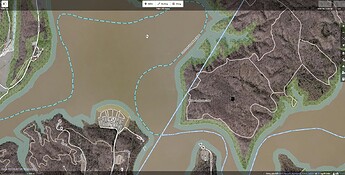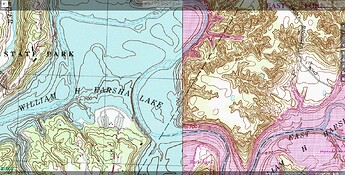In practice, it often is an eyeballed centerline, but some mappers try to make it represent the thalweg. Either way, we can think of it as an abstraction. The “centerline” of a V-shaped valley is another example of an abstraction. In that case, thankfully no one expects mappers to delineate the valley floor based on precisely where it meets the foothills.
As a sidenote, mapping the thalweg is especially useful for rivers that run through reservoirs, as in the Lake Mead example earlier. An algorithmically generated lakeline has no context about where the river ran before the valley was inundated. In my own mapping, I’ve used public domain topographic maps or existing boundaries to determine where the thalweg ran. In cases where no such sources are readily available, eyeballing based on the lakeshore is certainly better than nothing. And ultimately the river channel may not be so great for labeling anyways, as in this reservoir that inundated quite a meander:

